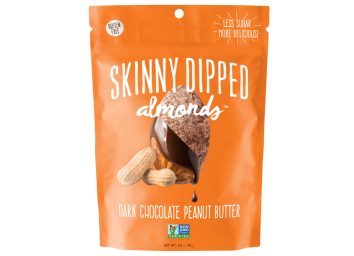Here's Why Everyone Is Talking About Ruby Chocolate

America is officially obsessed with the long-running U.K. series The Great British Baking Show. If you're a fan of the Netflix streaming show, you probably noticed one of the bakers, Priya O'Shea, used a new type of chocolate in Season 10, Episode 2 (Biscuit Week). O'Shea's dipped her Barfi Biscuit Bars in a pretty pale pink chocolate called ruby chocolate. (She's also still using it in her personal bakes.) Surprisingly, neither Paul nor Prue (GBBS iconic judges) had ever heard of or tasted ruby chocolate. And that's likely because it's so new.
What's being called the "fourth chocolate" (behind dark, milk, and white), ruby chocolate is a newly-discovered confection chocolate-eaters can't wait to get their hands on. Here's everything you need to know about what it is, why it's so special, and how to get your hands on it.
What is ruby chocolate?
Ruby chocolate was created by the Belgian chocolate manufacturer Barry Callebaut Group, and introduced in late 2017. Callebaut uses the "ruby cocoa bean", which is grown in Ecuador, Brazil and the Ivory Coast, to make ruby chocolate.
It sounds special, but The New York Times reports that genetically-speaking, the ruby beans are nothing new. "They come from the same species of cacao plant that begets the chocolate we already know," the Times notes. A Callebaut representative told the Times that the beans that earn ruby status have a particular mix of compounds, but wouldn't explain any further.
Why is it pink?
The company has been super hush-hush about the specifics of how the chocolate gets its pink color. According to the Barry Callebaut Group, it has no added colors or flavors.
Instead, ruby chocolate is actually just regular cocoa beans that have a "particular mix of compounds," which likely refers to high levels of pigmented polyphenols referred to in the chocolate's 2009 patent. Additionally, the patent notes Callebaut's unique processing technique also lends to the pink color.
The patent describes a way to make a "cocoa-derived material red or purple" by minimizing fermentation (3 days or less), treating the product with an acid, and using petroleum ether to remove fatty acids to preserve the color.
What does it taste like?
If you're a fan of berries and chocolate, you'll likely love Ruby Chocolate. Barry Callebaut describes the flavor as "neither bitter, milky, or sweet. It's rather a tension of fresh berry fruitiness and luscious smoothness." Other flavor notes include sour, yogurt, tart, and tangy.
"Ruby chocolate is quite sweet and tastes like raspberry-flavored white chocolate with some milk chocolate added," says Isabel Maples, MEd, RDN, registered dietitian nutritionist and spokesperson for the Academy of Nutrition and Dietetics.
How does ruby chocolate compare to white, milk and dark chocolate?
There is one catch to Ruby chocolate—technically, it's not defined as "chocolate" in the United States, due to the Food & Drug Administration's standards.
According to Lauren Bergan, director of innovation for market development at Barry Callebaut North America, this is why the FDA hasn't deemed it "chocolate."
"The FDA has a code of federal regulations that define food categories based on what ingredients can or need to be in there, the maximum or minimum amount of certain ingredients, and the percentage of ingredient compositions," says Bergan.
"Ruby technically has all of those ingredients that appear in regular chocolate: cocoa butter, sugar, milk powder, and unsweetened chocolate," she says. However, there's a catch.
While ruby chocolate contains the necessary ingredients to match the FDA's definition of chocolate, it doesn't meet the right percentages. It has too much unsweetened chocolate to be white chocolate and not enough unsweetened chocolate to be milk chocolate. As for dark chocolate? "From a visual and flavor perspective, this is definitely not dark chocolate, so we [need a] fourth definition," Bergan says.
Here is more on how the FDA defines chocolate, which can get pretty tricky, according to Maples:
- Milk chocolate must contain at least 10% chocolate liquor and at least 12% milk solids. It also must contain no fats other than cocoa butter and milk solids.
- Semisweet chocolate must contain at least 35% cocoa butter to meet FDA's standard of identity.
- Sweet chocolate must have at least 15% chocolate liquor and may contain more sugar than semisweet chocolate is allowed to.
- White chocolate is not true chocolate because it doesn't contain any chocolate liquor.
Does ruby chocolate have any nutritional benefits?
"Since ruby chocolate is supposedly from cocoa beans, like true chocolates, it may contain flavanols, a type of phytonutrient. Phytonutrients are natural compounds that offer a health benefit," says Maples.
Here are a few other nutritional benefits chocolate offers:
- Chocolate contains stearic acid, a saturated fat that doesn't seem to raise cholesterol levels.
- Chocolate seems to act as an antioxidant. Dark chocolate, because it contains more chocolate liquor, has more flavanols than milk chocolate. (Dutch process chocolate—also known as "alkalized" chocolate—doesn't have these chocolate benefits since the alkaline used to process it removes the flavanols.)
While these are well-known benefits of chocolate, researchers haven't verified the same perks apply to ruby chocolate.
"I'm not aware of any testing to verify the phytonutrient content of ruby chocolate and to verify that the acid used to treat the cocoa beans doesn't affect the flavanol activity," says Maples.
Where can you buy it?
Ruby chocolate is slowly entering the U.S. market. Trader Joe's recently sold it for a limited time (and it's still available on Amazon). Plus, KitKat Ruby, which is currently available in Japan, South Korea, and the United Kingdom, may soon be sold in the United States.
In the meantime, here are a few online retailers where you can buy ruby chocolate now.








